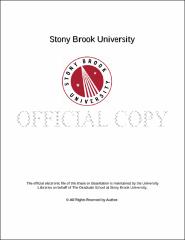| dc.identifier.uri | http://hdl.handle.net/11401/76655 | |
| dc.description.sponsorship | This work is sponsored by the Stony Brook University Graduate School in compliance with the requirements for completion of degree. | en_US |
| dc.format | Monograph | |
| dc.format.medium | Electronic Resource | en_US |
| dc.language.iso | en_US | |
| dc.publisher | The Graduate School, Stony Brook University: Stony Brook, NY. | |
| dc.type | Dissertation | |
| dcterms.abstract | This dissertation is divided into three main parts where we derive various properties of the T-dually extended superspaces. In the first part we reformulate the manifestly T-dual description of the massless sector of the closed bosonic string, directly from the geometry associated with the (left and right) affine Lie algebra of the coset space Poincar Ì e/Lorentz. This construction initially doubles not only the (space- time) coordinates for translations but also those for Lorentz transformations (and their “dual†). As a result, the Lorentz connection couples directly to the string (as does the vielbein), rather than being introduced indirectly through covariant derivatives as previously. This not only reproduces the old definition of T-dual torsion, but automatically gives a general, covariant definition of T-dual curvature (but still with some undetermined connections). In the second part we give the manifestly T-dual formulation of the massless sector of the classical 3D Type II superstring in off-shell 3D N = 2 superspace, including the action. It has a simple relation to the known superspace of 4D N = 1 supergravity in 4D M-theory via 5D F-theory. The pre-potential appears as part of the vielbein, without derivatives. In the last and the most involved part we find the pre-potential in the superspace with AdS5 × S5 background. The pre-potential appears as part of the vielbeins, without derivatives. In both subspaces (AdS5 and S5) we use Poincare coordinates. We pick one bulk coordinate in AdS5 and one bulk coordinate in S5 to define the space-cone gauge. Such space-cone gauge destroys the bulk Lorentz covariance. However, it still preserves boundary Lorentz covariance (and gives projective superspace) SO ( 3, 1) ⊗ SO (4) and so symmetries of boundary CFT are manifest. | |
| dcterms.available | 2017-09-20T16:50:53Z | |
| dcterms.contributor | Rocek, Martin | en_US |
| dcterms.contributor | Siegel, Warren | en_US |
| dcterms.contributor | Nieuwenhuizen, Peter van | en_US |
| dcterms.contributor | Du, Xu | en_US |
| dcterms.contributor | Khuri, Marcus. | en_US |
| dcterms.creator | Polacek, Martin | |
| dcterms.dateAccepted | 2017-09-20T16:50:53Z | |
| dcterms.dateSubmitted | 2017-09-20T16:50:53Z | |
| dcterms.description | Department of Physics | en_US |
| dcterms.extent | 116 pg. | en_US |
| dcterms.format | Application/PDF | en_US |
| dcterms.format | Monograph | |
| dcterms.identifier | http://hdl.handle.net/11401/76655 | |
| dcterms.issued | 2017-05-01 | |
| dcterms.language | en_US | |
| dcterms.provenance | Made available in DSpace on 2017-09-20T16:50:53Z (GMT). No. of bitstreams: 1
Polacek_grad.sunysb_0771E_13327.pdf: 659001 bytes, checksum: ab828d1b2ee8b4861cf60b68a45c33b5 (MD5)
Previous issue date: 1 | en |
| dcterms.publisher | The Graduate School, Stony Brook University: Stony Brook, NY. | |
| dcterms.subject | Physics | |
| dcterms.subject | F theory, String theory, Supergravity, T-duality | |
| dcterms.title | Aspects of T-dually extended Superspaces | |
| dcterms.type | Dissertation | |

